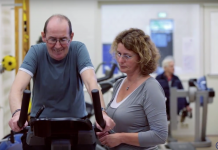Wetenschappers beweren dat ze de pijn die veroorzaakt wordt door artritis kunnen halveren. Dat doen ze eenvoudigweg door patiënten een optische illusie voor te schotelen. Een merkwaardige behandeling, want hierbij komt geen enkele pijnstiller aan te pas.
Computergestuurde beeldtechnologie neemt atritritis-patiënten in de maling door middel van een optische illusie. Onderzoekers namen de proef op de som door de handen van een reeks patiënten in een doos met een camera te steken. Het gemanipuleerde beeld van de handen werd vervolgens op een scherm geprojecteerd.
De proefpersonen kregen het gevoel dat ze hun vingers stretchten, ook al gebeurde er in werkelijkheid helemaal niets. In 85 procent van de gevallen werd de pijn gehalveerd. Sommige deelnemers waren er van overtuigd dat de pijn helemaal verdwenen was.
Per toeval ontdekt
Dit pijnverlichtend hulpmiddeltje werd per toeval ontdekt tijdens een opendeurdag aan de universiteit van Nottingham. “Tijdens een workshop stak een oudere dame met artritis haar hand in de machine waarna ze beweerde dat ze geen pijn meer voelde in haar vingers. We waren allen met verstomming geslagen.” zegt dokter Catherine Preston die aan de studie meewerkte.
Het team van wetenschappers kreeg niet lang daarna een beurs om een onderzoek op poten te zetten. Hoewel de studie nog in een vroeg stadium zit, spreken de onderzoekers van veelbelovende resultaten.
Bron: hln.be







Het principe hiervan is helemaal niet nieuw het komt van “mirror box” therapie ontwikkeld door prof. Ramachandran.
From Wikipedia,
A diagrammatic explanation of the mirror box. The patient places the good limb into one side of the box (in this case the right hand) and the amputated limb into the other side. Due to the mirror, the patient sees a reflection of the good hand where the missing limb would be (indicated in lower contrast). The patient thus receives artificial visual feedback that the “resurrected” limb is now moving when they move the good hand. See text for more details.
A mirror box is a box with two mirrors in the center (one facing each way), invented by Vilayanur S. Ramachandran to help alleviate phantom limb pain, in which patients feel they still have a limb after having it amputated.
Based on the observation that phantom limb patients were much more likely to report paralyzed and painful phantoms if the actual limb had been paralyzed prior to amputation (for example, due to a brachial plexus avulsion), Ramachandran and Rogers-Ramachandran proposed the “learned paralysis” hypothesis of painful phantom limbs (Ramachandran & Blakeslee 1998). Their hypothesis was that every time the patient attempted to move the paralyzed limb, they received sensory feedback (through vision and proprioception) that the limb did not move. This feedback stamped itself into the brain circuitry through a process of Hebbian learning, so that, even when the limb was no longer present, the brain had learned that the limb (and subsequent phantom) was paralyzed. Often a phantom limb is painful because it is felt to be stuck in an uncomfortable or unnatural position, and the patient feels they cannot move it.
To retrain the brain, and thereby eliminate the learned paralysis, Ramachandran and Rogers-Ramachandran (Ramachandran, Rogers-Ramachandran & Cobb 1995) created the mirror box. The patient places the good limb into one side, and the stump into the other. The patient then looks into the mirror on the side with good limb and makes “mirror symmetric” movements, as a symphony conductor might, or as we do when we clap our hands. Because the subject is seeing the reflected image of the good hand moving, it appears as if the phantom limb is also moving. Through the use of this artificial visual feedback it becomes possible for the patient to “move” the phantom limb, and to unclench it from potentially painful positions. Because this visual feedback elicits kinesthetic sensations, Ramachandran and Rogers-Ramachandran (Ramachandran & Rogers-Ramachandran 1996) refer to this as a kind of visual-kinesthetic synesthesia, although this is true only in the broadest sense of the term.
A diagram of a mirror box. A patient inserts their hand into one hole, and their “phantom” into the other. When viewed from an angle, the brain is tricked into seeing two complete hands.
Repeated training in some subjects has led to long-term improvement (Ramachandran & Blakeslee 1998), and in one exceptional case, even to the complete elimination of the phantom limb between the hand and the shoulder (so that the phantom hand was dangling from the shoulder). Subsequently, the use of the mirror box has been extended to rehabilitation of hemiparesis, or paralysis one side of the body, due to stroke (Altschuler et al. 1999) and to rehabilition of spatial neglect (Ramachandran et al. 1999). These extensions have met with moderate success, but further research is required to evaluate their clinical effectiveness.
Recently, Herta Flor and colleagues have performed functional neuroimaging experiments to explore the neural reorganization that leads to phantom limb pains. They find that telescoping phantoms lead to greater cortical reorganization (and associated pain) (Karl et al. 2004), while use of the mirror reverses these changes, and thereby leads to a reduction in pain (Flor et al. 2006). For example, in phantom limbs due to arm amputation, Flor and colleagues find that the distance the representation of the lip has been displaced predicts the degree of pain. However, with the mirror box, the representation of the lip is no longer displaced relative to its counterpart in the other (non-affected) hemisphere. That is, use of the mirror box can eliminate the remapping associated with phantom limb pains.